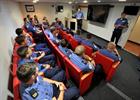Baggers back to sea
RNAS Culdrose Sea Kings from the Royal Navy’s Airborne Surveillance Force are gaining their sea legs again after operating for the past two years over the deserts of Afghanistan.
857 Naval Air Squadron, who fly Sea King Mk 7 Airborne Surveillance and Control helicopters, are affectionately known as “Baggers” because of the radar being held in a large Kevlar bag on the side of the aircraft. During their extended period on Operation Herrick duty in Afghanistan they completed in excess of 3,000 flying hours spread over 800 missions from Camp Bastion, the main operating Base for British Forces in the country. Swapping their Multi-Terrain Combats, they are getting familiar once again with traditional Naval Blue, and a return to Maritime operations.
“It's a fantastic opportunity to be back at sea as part of our maritime training period. RFA Argus offers us exactly the right platform in her role as the Fleet‘s Aviation Training Ship, said Lieutenant Commander James Hall, Commanding Officer of 857 NAS. “Up to 70% of my people have not been at sea recently, for some the last time was during Operation Ellamy off the coast of Libya in 2011. However, team spirit, enthusiasm and professionalism have been fundamental to regaining the specialist skills required to safely and effectively integrate with the ship’s company. By the end of this embarkation we expect to have increased our preparations for any task we could face in the maritime environment”.
The “Baggers” are embarked for two weeks and in that time they will be showing many of the newbie’s what life at sea is all about. Lieutenant Shaun Parker is the squadrons Air Engineering Officer (AEO) and he knows it’s a gradual training process to get fully up to speed. “Getting everyone to think about flight deck safety and operating on a pitching and rolling deck in all weathers is crucial. Some of the squadron are experiencing this for the first time. You don’t really need to lash things down in the desert, but you do when you’re at sea in the English Channel”.
The onboard training includes many aspects the squadron needs to operate in the Maritime environment. Pilots are getting deck current again and Observers carrying out basic radar handling of the aircraft to intercept ships and aircraft in the South West Approaches off the coast ofCornwall. Adopting a “Crawl – Walk – Run” training philosophy, the squadron’s engineers are beginning once again to get to-grips with ship borne procedures. Starting with the basics and working together as a team on the flight deck and down below in Argus’s large hangar.
“I’ve been on the squadron for about 18 months now, and completed three Afghan tours on Herrick, this is my first time onboard,” said Air Engineering Technician (AET) Martin Hetherington, one of the younger members of the squadron. “Everything takes longer and there’s a lot to learn, I’m really enjoying working the flight deck in all weathers, you have to be switched on and know what’s going on around you.”
857 NAS return to Royal Naval Air Station Culdrose after their short deployment onboard RFA Argus and begin planning for future operations and exercises with the Fleet later on in the year. This will also offer a period of rest and recuperation for both Squadron personnel and their families and their important supporting role behind the scenes.






